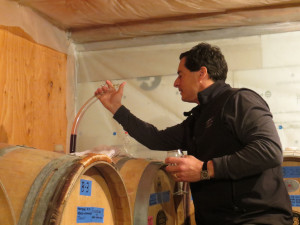University of Minnesota Grape Cultivars Increase at the Mid-American Wine Competition
Frontenac Gris is one of the more unique grape cultivars released from the University of Minnesota. It made its debut in 2003 and was first introduced as a separate wine category at the Mid-American Wine Competition in 2011. This new category was added due to an increased interest in Frontenac Gris.
The number of Frontenac Gris entries has increased every year. Submissions of the cold climate cultivar increased 60% in 2011 and 80% in 2012.
One of the unique traits of Frontenac Gris wines is the variability in color. Frontenac Gris appears to have more pigments than other gris cultivars like Pinot Gris. Some wineries produce Frontenac Gris using typical white wine production methods, while others produce it as a rosé/blush. Thus, the wine color can range from a traditional white to a pink, peach or salmon as noted in Katie Cook’s University of Minnesota blog.
The importance and future of Frontenac Gris was put in the forefront when in 2009 Prairie Berry Winery of Hill City, SD, won the Sweepstakes Award for the Best Rosé/Blush in the Mid-American Wine Competition. Judges and organizers at the Competition knew that Frontenac Gris had potential, but this award cemented that potential and thus led to the inception of the Frontenac Gris category.
See related story: Frontenac Gris Moves Beyond Minnesota

Winemaker Steve Zeller of Parley Lake Winery in Waconia, MN won the Sweepstakes Award for Best Dry Red Wine at the 2012 Mid-American Wine Competition for his Marquette wine.
The release of Marquette from the University of Minnesota in 2006 was met with much anticipation. For many winemakers and grape growers, Marquette was supposed to be the cold-hardy red grape hybrid most suited for dry red wine production. The fruit composition of Marquette was reported to be lower in acid and have better tannins than its predecessor, Frontenac.
According to the Minnesota Grape Growers Profile in 2007, Marquette was the most planted grape cultivar in vineyards younger than four years old. It also was third in terms of total tons of grapes harvested in Wisconsin in 2010.
Marquette was estimated to be first in total tonnage harvested in 2011 and first in terms of most likely cultivar planted in new vineyards (Report of the Wisconsin Grape Growers Survey 2011.) Marquette is also being grown in New England as well, according to the Napa Valley Register.
While expectations have been quite high for Marquette, many believe that this grape cultivar is starting to live up to the hype around its introduction. Growers of Marquette are learning how to handle some of the unique traits of this grape cultivar as compared with Frontenac.
Marquette tends to need to be harvested earlier, typically has fewer and smaller clusters, and has a growth habit unlike Frontenac. The versatility of Marquette allows it to be grown on various training systems; however its tendency for early budbreak is cause for concern for many growers.
Many Marquette vineyards have begun to bear fruit in the last few years allowing wineries to begin trials of different wine production methods. In 2012, there was a 200% increase in the number of Marquette wines entered at the Mid-American Wine Competition.
This increase was highlighted when Parley Lake Winery in Waconia, MN won the Sweepstakes Award for the Best Dry Red Wine in the 2012 Mid-American Wine Competition. The Competition believes that this grape holds a great deal of potential for quality wine production in many grape growing regions.
References
http://www.grapes.umn.edu/Frontenacgris/index.htm
http://enology.umn.edu/2012/04/19/frontenac-gris-rose/
http://napavalleyregister.com/lifestyles/food-and-cooking/wine/marquette-a-grape-worth-getting-to-know/article_f1d3ae9e-2a20-11e2-be32-0019bb2963f4.html
http://faculty.apec.umn.edu/wgartner/documents/FINAL_report_profile.pdf
http://wigrapes.org/wp-content/uploads/2011/12/Report-of-the-Wisconsin-Grape-Growers-Survey-2011.pdf\
This article was a joint venture between the Mid-Amercian Wine Competition and Midwest Wine Press



Randal,
I have a 3 acre vineyard in Pepin, Wisconsin. One of my red wine grape varieties mutated (just one cordon) to produce a stunning white grape. The other cordon is still producing a the original red grape. It’s a pretty amazing sight to see one vine producing two very different color grapes.
How to do I go about naming and registering this mutation to my vineyard?
Do I start with the Univerity of Wisconsin?
Please let me know your thoughts/direction. Thank you,
John Betancourt
Cell 305 213 2042